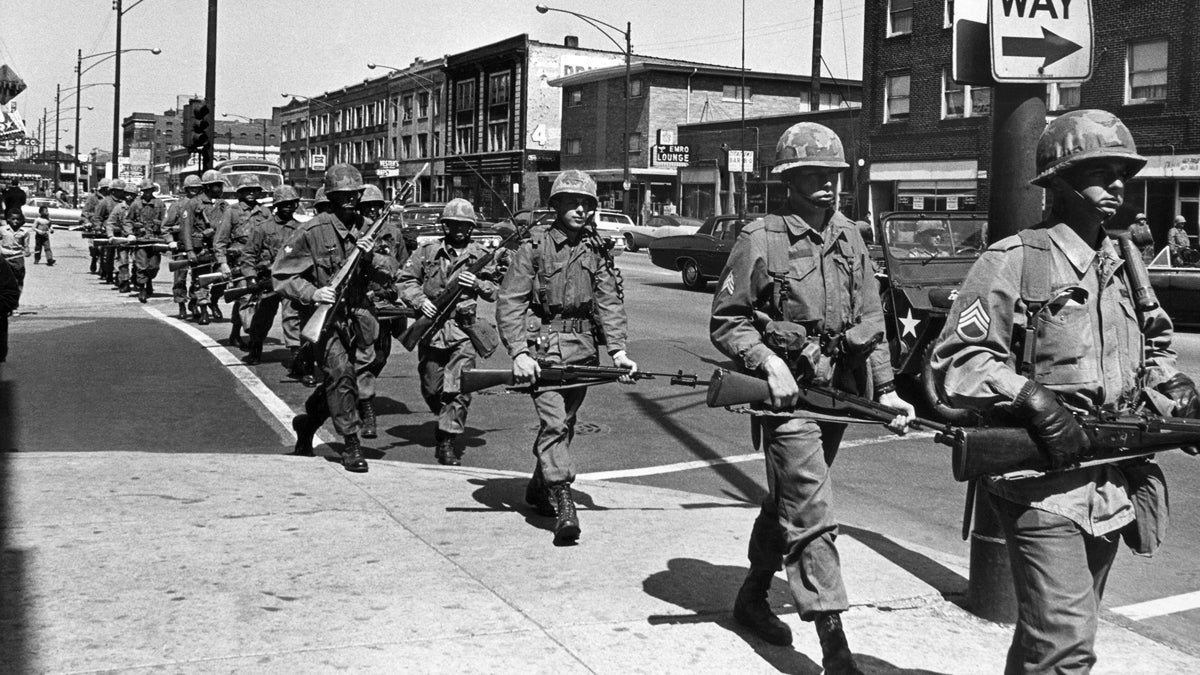Take a breath, folks, 2016 is not 1968

With fixed bayonets
The latest fad, propagated by many members of the commentariat, is to equate the America of 2016 with the America of 1968. I heard it again yesterday, from Chuck Todd of NBC News: “Not since the summers of the ’60s and violence in Watts, Detroit, and Chicago has the nation felt so hopelessly divided.”
This meme is particularly popular among those who have no living memories of 1968. Todd, in fact, was not on this earth in 1968. But I myself was very much alive — as a high school kid who paid close attention to the news — and if it’s any comfort to those of you who are freaked about the latest race-based events, I can state with a high degree of confidence that America was far, far worse in 1968.
Let’s take a deep breath and put things in perspective. Ask yourself whether these events were more dire than anything that’s happening now:
The nation’s most prominent civil rights leader bled out on a motel balcony after his jaw was shattered by a racist’s bullet that traveled at a velocity of 2,670 feet per second. Just two months later, a major presidential candidate got whacked in a hotel kitchen moments after winning a pivotal primary. In the time between the King and Kennedy assassinations, huge swaths of our nation’s capital went up in flames. The U.S. attorney general watched it from the air, as recounted by author Hampton Sides:
“Smoke engulfed all of downtown and the Mall. Only the great illuminated dome of the Capitol and the sharp white obelisk of the Washington Monument punctured the seething blankets …. the pilot thought it looked like Dresden. All told, more than 500 fires had been set throughout the city. At President Johnson’s behest, much of the District was now occupied by federal troops, spearheaded by the Third Infantry Regiment …. The White House was reinforced with sandbags and ringed with troops …. Machine gun nests were erected all around the Mall and the Capitol building, where soldiers, some fresh from Vietnam, stood in nervous vigil, their rifles fixed with bayonets.”
Twelve people died in the D.C. riots, and 1,600 were injured. And the death toll was higher in the two most serious riots that raged a year earlier — in Detroit (43 dead, more than 1,000 injured) and in Newark (27 dead, roughly 1,000 injured). Chuck Todd also mentioned Watts, the L.A. neighborhood that burned in 1965, but the toll there — 34 dead, another 1,000 injured — was far more dire than any of the disturbances today. The U.S. Army was sent to Detroit as well. Imagine the hysteria today, fanned by social media and the 24/7 cable cycle, if the U.S. Army was fighting in our streets.
Todd also mentioned “Chicago.” Presumably this was a reference to the street violence outside the Democratic Convention, where Mayor Richard Daley’s cops clashed with kids protesting the Vietnam war. Ah yes, Vietnam. The year 1968 was the high mark for the demise of American boys. It’s almost an insult, to those of us who experienced 1968, to equate it with 2016. According to the official stats, 16,592 Americans died that year alone in Vietnam. An average of 45 guys each day. Imagine if that was happening now — 45 a day in a futile war — with millions of kids at home fearing the draft.
Obviously, I’m not trying to minimize our current civil unrest. But we should be able to console ourselves with the knowledge that ’68 was more horrific by every objective measure — even the homicide rate was markedly higher (6.9 per 100,000 Americans) than it is now (4.5 per 100,000, in 2014) — and that somehow we as a nation survived. Heck, today we have black police chiefs (thankfully, including Dallas), whereas, back then, big-city departments were overwhelmingly white. And today, the electorate is far more enlightened about race; according to a ’14 CNN-ORC poll, 51 percent of Americans said that blacks are treated unfairly by the criminal justice system (only 41 percent said the system treats whites and blacks equally).
One big caveat: This year is still young, and the party conventions are looming — I’ll be in Cleveland next week — so I suppose I could still be proven wrong.
We also have a presidential nominee who has romanced aggrieved white people like nobody since George Wallace — in the campaign of 1968. The good news is that not even Trump dares to traffic in the kind of hate rhetoric that Wallace employed in 1968 (“the nigra would still be in Africa in the brush if the white people of this country had not raised their standards”). On the other hand, Wallace never got near a major party nomination. Leave it to the Trump Republicans to keep Wallace’s spirit alive, albeit semi-sanitized.
But lest we forget, we have prominent voices eloquently urging calm. Republican House Speaker Paul Ryan, for instance: “This has been a long week for our country …. Every member of this [House], every Republican and every Democrat, wants to see less gun violence. Every member of this body wants a world in which people feel safe regardless of the color of their skin …. Sometimes we disagree on how to get there. But let’s not lose sight of the values that unite us. Let’s not lose sight of our common humanity.”
Those shared values helped us survive the nadir of ’68. I can’t help but believe that this time should be easier.
—
Follow me on Twitter, @dickpolman1, and on Facebook.
WHYY is your source for fact-based, in-depth journalism and information. As a nonprofit organization, we rely on financial support from readers like you. Please give today.

